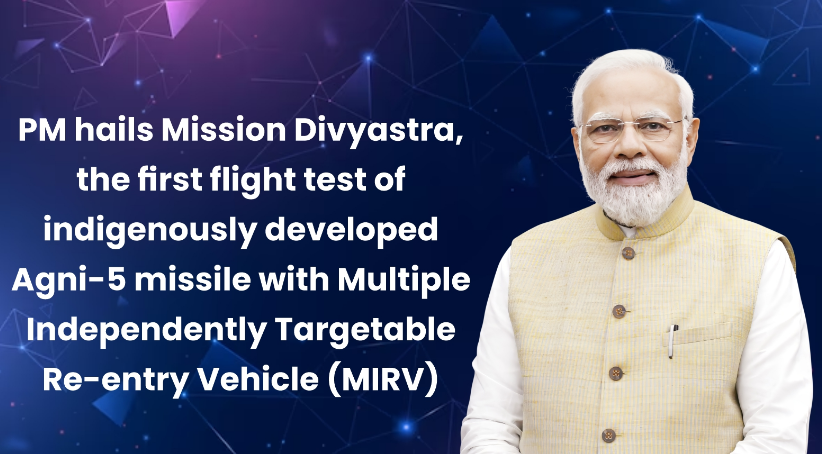Context:
India successfully conducted the first test launch of its Agni-V ballistic missile equipped with MIRV (Multiple Independently Targetable Re-entry Vehicle) technology.
Key highlights
- The Defence Research and Development Organisation (DRDO) under Mission Divyastra conducted the first successful flight test of indigenously developed Agni-5 missile with MIRV technology.
- Mission Divyastra: The flight test was conducted from Dr APJ Abdul Kalam Island in Odisha. Various telemetry and radar stations tracked and monitored multiple re-entry vehicles, and the mission accomplished the designed parameters.
- Indigenous Technology: The system is equipped with indigenous avionics systems and high accuracy sensor packages, showcasing India’s technological prowess.
- Member of elite group: With the success of Mission Divyastra, India has joined the select group of nations with MIRV technology. India is 6th country after the US, Russia, United Kingdom, France, and China to have this technology.
- Significant Contribution by Women: The project director for Mission Divyastra is a woman, highlighting significant contributions by women in India’s defence sector.
Significance of the Test
- Agni-V strengthens India’s credible minimum deterrence and bolsters its position as a major regional power.
- Self-Reliance: Showcases India’s indigenous missile technology advancement.
- The test marks an important milestone in India’s strategic capabilities, as India’s march towards greater geo-strategic significance and self-reliance (Atmanirbhar Bharat).
- The test enhances India’s capability against China and potentially against Pakistan, affecting regional dynamics and potentially leading to arms race concerns.
About MIRV Technology
- In contrast to a traditional missile, which carries one warhead, MIRVs can carry multiple warheads which can be released from the missile at different speeds and in different directions, thus greatly enhancing the missile’s destructive potential.
- After launch, these warheads separate during the final stages of flight and independently re-enter the atmosphere, targeting distinct locations.
- The development of MIRV technology is also difficult as it requires the combination of large missiles, small warheads, accurate guidance, and a complex mechanism for releasing warheads sequentially during flight.
- Compared to MRV (Multiple Re-entry Vehicle) technology, MIRV offers the advantage of independent targeting capability.

• Components:
- Missile Bus: The main body of the missile carrying the warheads and guidance systems for initial launch.
- Re-entry Vehicles (RVs): Individual warheads designed to survive atmospheric re-entry and detonate on separate targets.
Key Features of Agni-V
- Agni-V is an intercontinental ballistic missile (ICBM) developed by DRDO
- It is the most advanced surface-to-surface missile in India’s arsenal.
- Range: Exceeds 5,000 km, placing targets across Asia and parts of Europe within reach.
- Propulsion: Three-stage, solid-fueled engine for high thrust and operational simplicity, capable of carrying a 1.5-tonne nuclear warhead.
- Launch Platforms: Road-mobile and canisterized, enabling greater mobility, launch flexibility, and weather protection.
- Warhead: Designed to carry nuclear warheads for strategic deterrence.
- MIRV Capability: With the success of Mission Divyastra, Agni V can carry multiple warheads from a single missile.
IGMDP (Integrated Guided Missile Development Program)
The Agni missile, developed in the 1990s under India’s IGMDP, was one of several missiles developed alongside the Prithvi, Nag, Akash, and Trishul missiles.
IGMDP (1983-2008): This ambitious program aimed to establish India’s self-sufficiency in missile technology.
Other recent developments
- Nuclear Triad: India has completed its nuclear triad with the induction of INS Arihant, indigenously built nuclear ballistic missile submarine, ensuring operational second-strike capability.
- Previous Demonstrations: DRDO had previously demonstrated Anti-Satellite (ASAT) capability under Mission Shakti in March 2019, further highlighting India’s advancements in defence technology.

